高三英语第9单元教案
- 格式:doc
- 大小:51.50 KB
- 文档页数:18
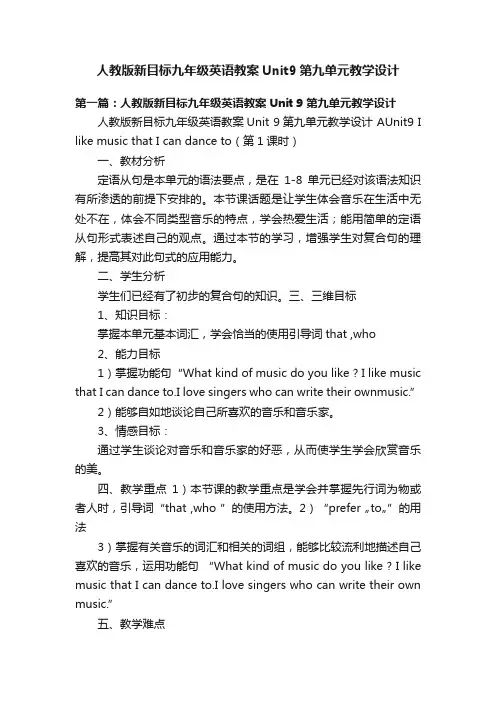
人教版新目标九年级英语教案Unit9第九单元教学设计第一篇:人教版新目标九年级英语教案Unit 9第九单元教学设计人教版新目标九年级英语教案Unit 9第九单元教学设计 AUnit9 I like music that I can dance to(第1课时)一、教材分析定语从句是本单元的语法要点,是在1-8单元已经对该语法知识有所渗透的前提下安排的。
本节课话题是让学生体会音乐在生活中无处不在,体会不同类型音乐的特点,学会热爱生活;能用简单的定语从句形式表述自己的观点。
通过本节的学习,增强学生对复合句的理解,提高其对此句式的应用能力。
二、学生分析学生们已经有了初步的复合句的知识。
三、三维目标1、知识目标:掌握本单元基本词汇,学会恰当的使用引导词that ,who2、能力目标1)掌握功能句“What kind of music do you like ? I like music that I can dance to.I love singers who can write their ownmusic.”2)能够自如地谈论自己所喜欢的音乐和音乐家。
3、情感目标:通过学生谈论对音乐和音乐家的好恶,从而使学生学会欣赏音乐的美。
四、教学重点1)本节课的教学重点是学会并掌握先行词为物或者人时,引导词“that ,who ”的使用方法。
2)“prefer …to…”的用法3)掌握有关音乐的词汇和相关的词组,能够比较流利地描述自己喜欢的音乐,运用功能句“What kind of music do you like ? I like music that I can dance to.I love singers who can write their own music.”五、教学难点定语从句运用六、教学策略采用任务型语言教学,实施情境教学法、小组合作探究法、情感激励法。
七、教学准备自制多媒体课件(PowerPoint);录音机(A tape recorder)八、教学环节1、课堂导入⑴ Warming up ⑵ Discuss: Do you like music? What kind ofmusic do you know? ⑶ There aremany kinds of music such as pop ,jazz, rock…….Let Sstalk about the kinds of music..(多媒体出示)⑷Let Ss read 1a.Explain the sentences: I prefermusic that has great lyrics=I like music that has great lyrics better.lyrics:the plural form is often used.Ask Ss topractice in pairs then make up a short passage using the four sentences on thescreen.2、课堂讲授Explain attributive clauses.定语从句:在复合句中修饰名词或者代词的从句叫做定语从句。
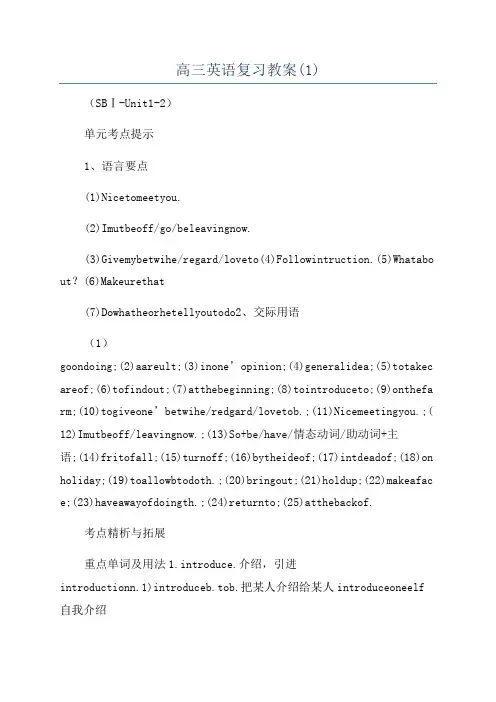
高三英语复习教案(1)(SBⅠ-Unit1-2)单元考点提示1、语言要点(1)Nicetomeetyou.(2)Imutbeoff/go/beleavingnow.(3)Givemybetwihe/regard/loveto(4)Followintruction.(5)Whatabo ut?(6)Makeurethat(7)Dowhatheorhetellyoutodo2、交际用语(1)goondoing;(2)aareult;(3)inone’opinion;(4)generalidea;(5)totakec areof;(6)tofindout;(7)atthebeginning;(8)tointroduceto;(9)onthefa rm;(10)togiveone’betwihe/redgard/lovetob.;(11)Nicemeetingyou.;( 12)Imutbeoff/leavingnow.;(13)So+be/have/情态动词/助动词+主语;(14)fritofall;(15)turnoff;(16)bytheideof;(17)intdeadof;(18)on holiday;(19)toallowbtodoth.;(20)bringout;(21)holdup;(22)makeafac e;(23)haveawayofdoingth.;(24)returnto;(25)atthebackof.考点精析与拓展重点单词及用法1.introduce.介绍,引进introductionn.1)introduceb.tob.把某人介绍给某人introduceoneelf 自我介绍注意:其后不能跟双宾语,类似的词还有e某plain,ugget2)introduceanewidea引入一种新思想2.practice实践;学习Practicemakeperfect.熟能生巧。
1)短语:inpractice在实践中;实际上putth.intopractice实施2)比较:practice和e某ercie当“练习”解时的不同,practice指有规律的练习,特指反复练习,e某ercie一般用语,可指训练,锻炼,操练等。
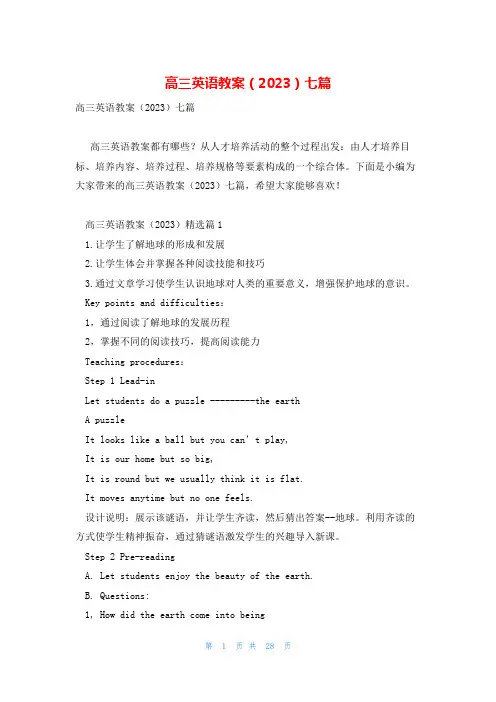
高三英语教案(2023)七篇高三英语教案(2023)七篇高三英语教案都有哪些?从人才培养活动的整个过程出发:由人才培养目标、培养内容、培养过程、培养规格等要素构成的一个综合体。
下面是小编为大家带来的高三英语教案(2023)七篇,希望大家能够喜欢!高三英语教案(2023)精选篇11.让学生了解地球的形成和发展2.让学生体会并掌握各种阅读技能和技巧3.通过文章学习使学生认识地球对人类的重要意义,增强保护地球的意识。
Key points and difficulties:1,通过阅读了解地球的发展历程2,掌握不同的阅读技巧,提高阅读能力Teaching procedures:Step 1 Lead-inLet students do a puzzle ---------the earthA puzzleIt looks like a ball but you can’t play,It is our home but so big,It is round but we usually think it is flat.It moves anytime but no one feels.设计说明:展示该谜语,并让学生齐读,然后猜出答案--地球。
利用齐读的方式使学生精神振奋,通过猜谜语激发学生的兴趣导入新课。
Step 2 Pre-readingA. Let students enjoy the beauty of the earth.B. Questions:1, How did the earth come into being2, In China, there are some stories about the beginning of life. Do you know设计说明:通过图片让学生感受地球,产生热爱地球家园的体验,同时让学生产生了疑问,地球是怎么形成的,顺利过渡到下一部分。
Step 3 Fast-reading1, Let students read the text quickly and then answer the following questions.(1) According to the text, how did the universe begin(2) What is the fundamental to the development of life(3) Where did life first begin, on the land or in the sea(4) Which kind of animal has become the most important animals on the planet today设计说明:设计几个较为简单却有关全局的问题,让学生带着问题快速搜索所需信息,锻炼学生快速阅读的能力。
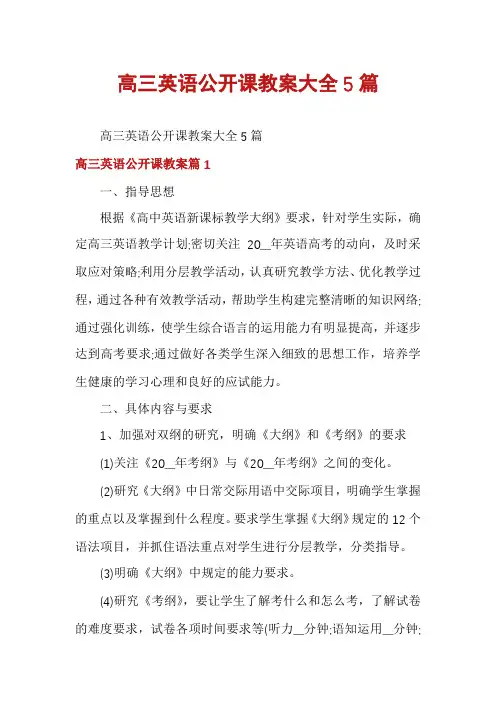
高三英语公开课教案大全5篇高三英语公开课教案大全5篇高三英语公开课教案篇1一、指导思想根据《高中英语新课标教学大纲》要求,针对学生实际,确定高三英语教学计划;密切关注20__年英语高考的动向,及时采取应对策略;利用分层教学活动,认真研究教学方法、优化教学过程,通过各种有效教学活动,帮助学生构建完整清晰的知识网络;通过强化训练,使学生综合语言的运用能力有明显提高,并逐步达到高考要求;通过做好各类学生深入细致的思想工作,培养学生健康的学习心理和良好的应试能力。
二、具体内容与要求1、加强对双纲的研究,明确《大纲》和《考纲》的要求(1)关注《20__年考纲》与《20__年考纲》之间的变化。
(2)研究《大纲》中日常交际用语中交际项目,明确学生掌握的重点以及掌握到什么程度。
要求学生掌握《大纲》规定的12个语法项目,并抓住语法重点对学生进行分层教学,分类指导。
(3)明确《大纲》中规定的能力要求。
(4)研究《考纲》,要让学生了解考什么和怎么考,了解试卷的难度要求,试卷各项时间要求等(听力__分钟;语知运用__分钟;阅读理解x分钟;写x分钟)。
(5)分析20__年高考英语试题(__卷、全国卷),把握考试方向。
2、加强对《大纲》和《考纲》中词汇复习的研究研究《大纲》词汇的内涵和外延度,特别是动词的用法。
优化词汇的教学方法,不能以单词默写来代替词汇训练。
研究学生掌握词汇的状况,在过度教材学习中注意《大纲》词汇的识记和运用,特别是派生词、合成词和多义词等用法的训练,做到词不离句,句不离章。
3、高三英语教材教学(1)要认真扎实地完成高三英语教材选修x的教学任务。
教法上可以将精读和泛读结合起来,目的主要是培养学生英语阅读理解能力。
对课文中的练习可以选择一些重点。
(2)确因教材的难度太大,已不适合作为语言输入的材料,可以选择一些难度相对较低的课文,对学生进行阅读理解的训练。
另外以《20__年高三导与练第一轮英语复习资料》为补充材料,打好学生基础。
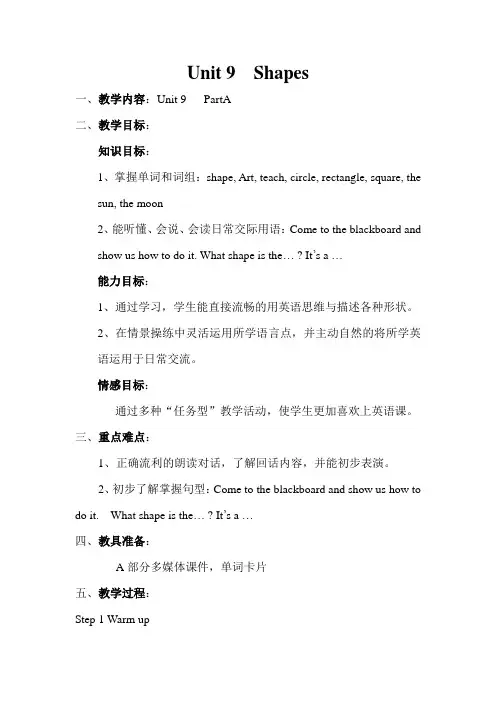
Unit 9 Shapes一、教学内容:Unit 9 PartA二、教学目标:知识目标:1、掌握单词和词组:shape, Art, teach, circle, rectangle, square, thesun, the moon2、能听懂、会说、会读日常交际用语:Come to the blackboard andshow us how to do it. What shape is the… ? It’s a …能力目标:1、通过学习,学生能直接流畅的用英语思维与描述各种形状。
2、在情景操练中灵活运用所学语言点,并主动自然的将所学英语运用于日常交流。
情感目标:通过多种“任务型”教学活动,使学生更加喜欢上英语课。
三、重点难点:1、正确流利的朗读对话,了解回话内容,并能初步表演。
2、初步了解掌握句型:Come to the blackboard and show us how to do it. What shape is the… ? It’s a …四、教具准备:A部分多媒体课件,单词卡片五、教学过程:Step 1 Warm up1、Greetings.2、Free talkGlade to see you . Do you like kites/stars/singing/…? What do you like ?3、Sing a song 《Twinkle , twinkle , little star》二、Presentation1.由star导入课题Unit 9 Shapes(Look at the star , it’s a shape . Now this class we’ll learn Unit 9 Shapes. Can you spell ? s-h-a-p-e)2.Learn ‘Art , teach…about ’T: Boys and girls , look at my cards , I am an ________teacher. Am I an English teacher ? No,I’m an Art teacher . I’ll teach you about shapes.3.rectangleWhat shape is the picture ?It’s a rectangle .分音节指导朗读rec-tan-gle 指名读师生问答,生生问答。
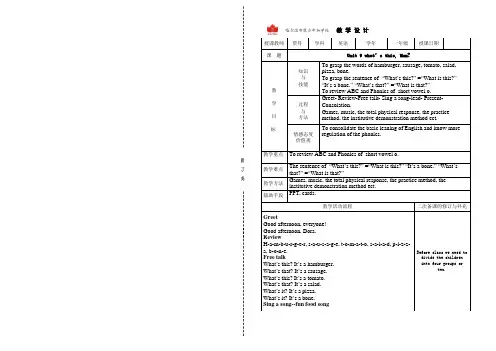
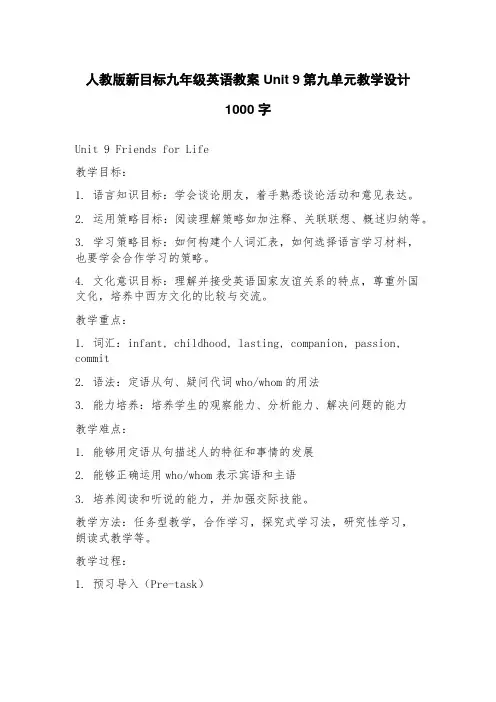
人教版新目标九年级英语教案Unit 9第九单元教学设计1000字Unit 9 Friends for Life教学目标:1. 语言知识目标:学会谈论朋友,着手熟悉谈论活动和意见表达。
2. 运用策略目标:阅读理解策略如加注释、关联联想、概述归纳等。
3. 学习策略目标:如何构建个人词汇表,如何选择语言学习材料,也要学会合作学习的策略。
4. 文化意识目标:理解并接受英语国家友谊关系的特点,尊重外国文化,培养中西方文化的比较与交流。
教学重点:1. 词汇:infant, childhood, lasting, companion, passion, commit2. 语法:定语从句、疑问代词who/whom的用法3. 能力培养:培养学生的观察能力、分析能力、解决问题的能力教学难点:1. 能够用定语从句描述人的特征和事情的发展2. 能够正确运用who/whom表示宾语和主语3. 培养阅读和听说的能力,并加强交际技能。
教学方法:任务型教学,合作学习,探究式学习法,研究性学习,朗读式教学等。
教学过程:1. 预习导入(Pre-task)通过显示26个英文字母,让学生回忆并列出所有以字母“F”开头的词汇,包括名词、形容词和动词。
教师在课堂前五分钟录下结果。
集体看一看,并补全缺少的词汇。
2. 输入新信息(Input)(1)任务1 完形填空让学生看到P63-P64的Team Building后,完成练习。
(2)任务2 阅读理解让学生阅读第一篇文章。
找到文章中描述朋友关系的词句,把它们圈起来。
(只用一分钟)接着,再读文章一遍,用自己的话回答问题。
(3)任务3 语法:定语从句a. 回忆练习:请学生跟随老师大声读一遍P66中的例句,并在课本上用横线把定语从句圈出来。
b. 给出Grammars P93中的定语从句。
分类规定。
c. 设计练习。
请学生阅读P93中的定语从句,并按照汉语意思,写出英语句子。
例如:我能听懂讲师讲英语的课。
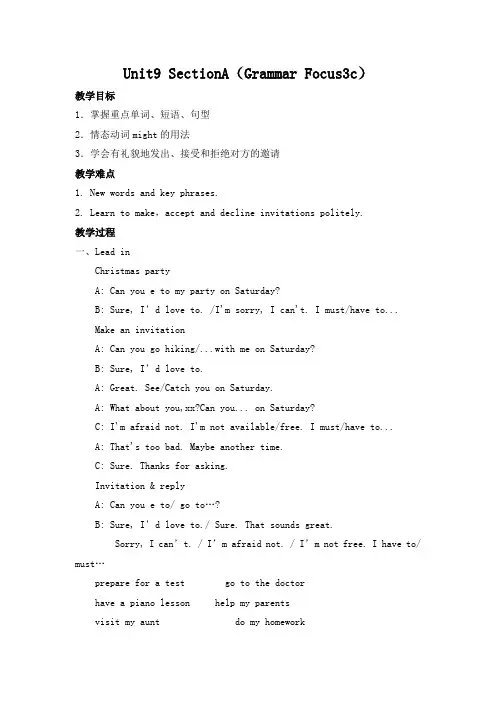
Unit9 SectionA(Grammar Focus3c)教学目标1.掌握重点单词、短语、句型2.情态动词might的用法3.学会有礼貌地发出、接受和拒绝对方的邀请教学难点1. New words and key phrases.2. Learn to make,accept and decline invitations politely.教学过程一、Lead inChristmas partyA: Can you e to my party on Saturday?B: Sure, I’d love to. /I'm sorry, I can't. I must/have to...Make an invitationA: Can you go hiking/...with me on Saturday?B: Sure, I’d love to.A: Great. See/Catch you on Saturday.A: What about you,xx?Can you... on Saturday?C: I'm afraid not. I'm not available/free. I must/have to...A: That's too bad. Maybe another time.C: Sure. Thanks for asking.Invitation & replyA: Can you e to/ go to…?B: Sure, I’d love to./ Sure. That sounds great.Sorry, I can’t. / I’m afraid not. / I’m not free. I have to/ must…prepare for a test go to the doctorhave a piano lesson help my parentsvisit my aunt do my homeworkA: Can he/she/they e to …?B: No, he/ she/ they can’t.He/ She/ They (might) have (has) to/ must…Grammar Focus3aplete the answers with might and one of the phrases in the box.watch TV on the weekend my cousin visit grandparentspractice the violin1. A: What are you going to do on Saturday?B: I'm not sure. I might ________________________2. A: What are you planning to do after school?B: I don't know. ______________________________3. A: When will you finish the science homework?B: __________________________________________4. A: Who are you going to the movies with?B: __________________________________________5. A: Are you free to e to my place on Saturday?B: __________________________________________3bplete the sentences below. Use the words in brackets to help you.1.Inviting:________________________ (can/play tennis)Accepting:_____________________2. Inviting: _________________________________________ (would like to/ go to the movies)Refusing: ____________________Reason: ___________________________________ (might have to)3. Inviting: _____________________________ (can/ hang out with us tonight)Refusing: ___________________Reason: _________________________(must)4. Inviting: __________________________________________ (would like to/e to my birthday party)Accepting:_____________________.2 You get these invitations but can't go. Write a refusal and areason.1. Invitation: "Can you e to my party on Saturday?"2. Invitation: "Let's go to the movies tomorrow night."3. Invitation: "Let's go to the concert on the weekend."4. Invitation: "Do you want to go shopping with me next week?"5. Invitation: "Can you play soccer with me after school today?"1. I’d like you to _________ (邀请) to dinner.2. They didn’t _________ (接受) his money.3. The girl __________ (拒绝) his invitation.4. Go straight down the street _______(直到) you see the bank.5. _________(悬挂) your clothes on the line.6.He _________(go) home until he finished his work.7. I like to ______ ______(闲逛) at mall with my friends.8. I have to run to ________ (赶) the bus.课堂练习同学们做exercisesthank you。
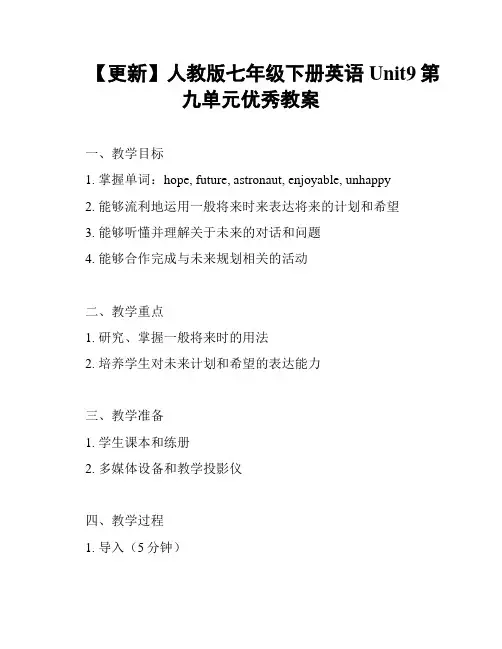
【更新】人教版七年级下册英语Unit9第九单元优秀教案一、教学目标1. 掌握单词:hope, future, astronaut, enjoyable, unhappy2. 能够流利地运用一般将来时来表达将来的计划和希望3. 能够听懂并理解关于未来的对话和问题4. 能够合作完成与未来规划相关的活动二、教学重点1. 研究、掌握一般将来时的用法2. 培养学生对未来计划和希望的表达能力三、教学准备1. 学生课本和练册2. 多媒体设备和教学投影仪四、教学过程1. 导入(5分钟)引导学生讨论一下他们的未来计划和希望,激发学生研究的兴趣和积极性。
2. 教学主体(30分钟)a. 复和引入新知识通过多媒体展示相关图片,引入新单词和短语,并帮助学生掌握其含义。
b. 教授一般将来时的用法详细解释一般将来时的构成和用法,例如:主语 + will + 动词原形。
通过示例句子和练帮助学生理解和掌握。
c. 练与拓展让学生进行口头和书面练,练运用一般将来时进行句子构造和对话。
同时,组织小组活动,让学生合作讨论自己的未来计划。
3. 巩固与反馈(15分钟)通过问题和对话练,巩固学生对一般将来时的掌握程度。
同时,对学生的合作活动进行评价,并给予反馈和鼓励。
五、教学延伸鼓励学生在家进行额外的练,巩固所学的知识。
可以提供一些相关的练题和研究资源。
六、教学评价通过对学生的口头和书面练进行评价,了解学生对一般将来时的掌握程度,并给予针对性的指导。
七、教学反思根据教学实际情况,对本节课的教学效果进行总结和反思,为下一次教学做出调整和提升。
八、课后作业完成课本和练习册上相关的练习题,并继续思考自己的未来计划和希望。
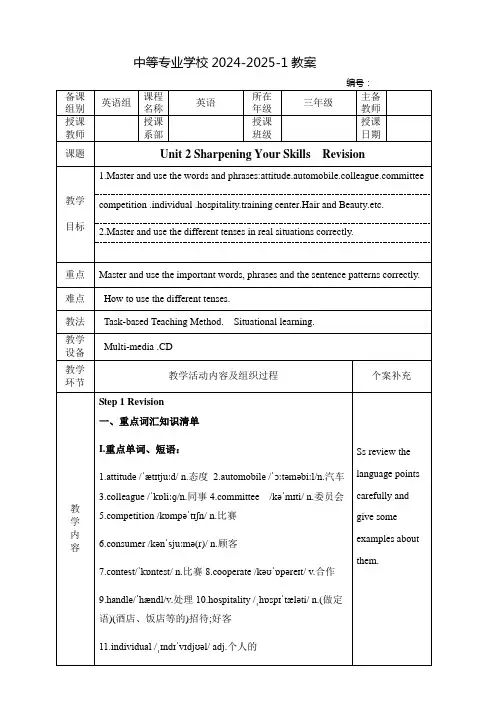
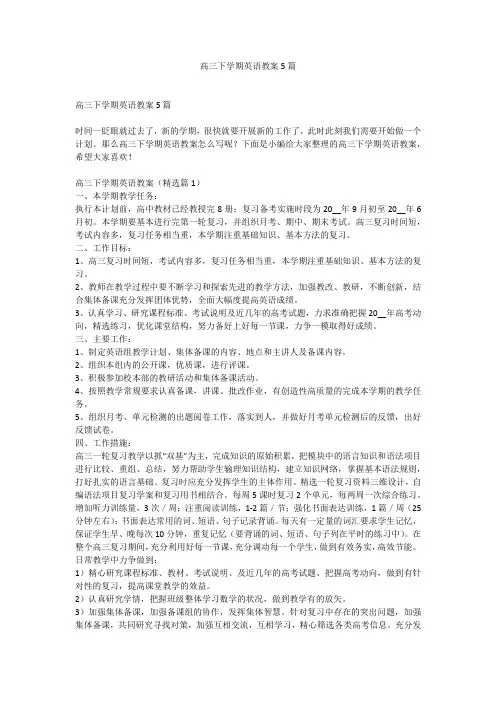
高三下学期英语教案5篇高三下学期英语教案5篇时间一眨眼就过去了,新的学期,很快就要开展新的工作了,此时此刻我们需要开始做一个计划。
那么高三下学期英语教案怎么写呢?下面是小编给大家整理的高三下学期英语教案,希望大家喜欢!高三下学期英语教案(精选篇1)一、本学期教学任务:执行本计划前,高中教材已经教授完8册;复习备考实施时段为20__年9月初至20__年6月初。
本学期要基本进行完第一轮复习,并组织月考、期中、期末考试。
高三复习时间短,考试内容多,复习任务相当重,本学期注重基础知识、基本方法的复习。
二、工作目标:1、高三复习时间短,考试内容多,复习任务相当重,本学期注重基础知识、基本方法的复习。
2、教师在教学过程中要不断学习和探索先进的教学方法,加强教改、教研,不断创新,结合集体备课充分发挥团体优势,全面大幅度提高英语成绩。
3、认真学习、研究课程标准、考试说明及近几年的高考试题,力求准确把握20__年高考动向,精选练习,优化课堂结构,努力备好上好每一节课,力争一模取得好成绩。
三、主要工作:1、制定英语组教学计划、集体备课的内容、地点和主讲人及备课内容。
2、组织本组内的公开课,优质课,进行评课。
3、积极参加校本部的教研活动和集体备课活动。
4、按照教学常规要求认真备课,讲课、批改作业,有创造性高质量的完成本学期的教学任务。
5、组织月考、单元检测的出题阅卷工作,落实到人,并做好月考单元检测后的反馈,出好反馈试卷。
四、工作措施:高三一轮复习教学以抓“双基”为主,完成知识的原始积累,把模块中的语言知识和语法项目进行比较、重组、总结,努力帮助学生输理知识结构,建立知识网络,掌握基本语法规则,打好扎实的语言基础。
复习时应充分发挥学生的主体作用。
精选一轮复习资料三维设计,自编语法项目复习学案和复习用书相结合。
每周5课时复习2个单元,每两周一次综合练习。
增加听力训练量,3次/周;注重阅读训练,1-2篇/节;强化书面表达训练,1篇/周(25分钟左右);书面表达常用的词、短语、句子记录背诵。
高三英语语法填空教案3篇高三英语语法填空教案篇1教学目标:知识与技能1、能够听说读写单词 again , put on, take off2、使用句型I like to____.表达个人喜好。
3、进一步复习掌握表示衣服名称的词和天气情况的单词。
过程与方法运用实物、图片等让学生获得感知采用小组活动的方式,有合作、有竞争情感态度与价值观让学生了解在不同的季节穿不同的衣服,培养学生的锻炼意识。
促使学生在日常生活中使用英语交际。
教学重点:本课的表示衣服名称的词和天气情况的单词重点单词again , put on, take off 及句型I like to____.。
教学难点:运用所学知识描绘自己的行为及动作。
教具学具:一些衣服实物、单词卡片、滑冰鞋、录音机、雪橇等。
教学过程:一、Class Opening and Review1、Play “Simon Says”学习“put on, take off“及所学衣服的词汇,例如:指名到教室前面,教师发指令,Put on your scarf. Take off your mitts.2、学生快速描述每位学生根据个人的实际情况说出自己所穿的衣服(可以用自己喜欢的方式) I am wearing ____. I like red .My sweater is red.3、(Ask and answer)问答练习(a)How many seasons are there in a year?(b)What’s your favorite season?(c)What do you wear in winter/spring/summer/fall?(d)What do you like to do in spring/summer/fall/winter?二、New conceptsa、skate, ski, learn, teach 教师拿出滑冰鞋,边做动作边说:“I like to skate on the ice. Can you skate? Do you want to learn? I can teach you.并用单词卡片学习“skate, learn, teach”b.用同样的方法教学“ski, I like to ski on the snow.”学生模仿并结合实际说句子。
高三英语复习教案大全高三英语复习教案大全七篇高三英语复习教案都有哪些?英语,满足我国对外交流、国家和地方经济社会发展、各类涉外行业、外语教育和学术研究需要的英语专业人才和复合型外语人才。
下面是小编为大家带来的高三英语复习教案大全七篇,希望大家能够喜欢!高三英语复习教案大全(篇1)一、课程类型:高三复习课二、教学目标:一) 认知目标1.句型和语言点(见教学重点)。
2.用所学的知识与伙伴进行交流、沟通,学会改错、写作。
二)情感目标利用多媒体手段营造积极和谐教学氛围,使学生不自觉地进入情景之中,充分调动学生的思维活动和情感体验,引起学生的共鸣。
三)智力目标在运用语言的过程中培养学生的观察力、分析力、想象力和自学能力,帮助学生加强记忆力,提高思维能力和运用英语的综合能力,激发创造能力。
三、教材分析:这是高三复习阶段的一节写作课。
这节书面表达课就从审题谋篇等方面入手来完成教学目的,侧重于引导学生在把握书面表达的写作前准备即谋篇审题能力,使学生在动手写作前迅速构思按照规范的模式来完成谋篇审题:在教学中不仅仅强调写,对于与写作紧密联系的听、说、读、改错都有兼顾。
采用任务型教学法和小组合作探究学习法,从而激发学生的学习兴趣,同时也能扩大课堂的语料输入量及学生的语言输出量。
四、教学重点:1. 学会审题和谋篇2. 掌握多样化的表达方式3. 熟练各段中的固定写作套路五、教学难点:1. 如何帮助学生运用写作策略,促进学生自主写作。
2. 使学生了解谋篇的重要性,培养谋篇的能力和习惯。
六、教学方法:1、活动教学法:2、任务型教学法:七、教学设计:Step 1. Warming upCome up with some proverbs for the students to put them into Chinese.Recitation is of the first importance in any language learning!Practice makes perfect! …What do you learn from the above proverbs?Step 2. PresentationMake it clear to the students the importance of writing in Englishsubject of the college entrance exams and then the goals of this lesson.Step 3. ExhibitionShow on the whiteboard a writing.高三英语复习教案大全(篇2)一、教学设计意图在《高中英语新课程标准》中讲到“高中英语课程要有利于学生优化英语学习方式,使他们通过观察、体验、探究等积极主动的学习方法,充分发挥自己的学习潜能,形成有效的学习策略,提高自主学习的能力;要有利于学生学会运用多种媒体和信息源,拓宽学习渠道并形成具有个性的学习方法和风格。
九年英语第9单元第1课时教案Lesson 1 of Unit 9 in the Ninth Grade English Curriculum。
Title: Lesson Plan for Unit 9, Lesson 1 of Ninth Grade English。
Objective:By the end of this lesson, students will be able to:Understand and use vocabulary related to travel and transportation。
Use the present perfect tense to talk about experiences。
Develop their speaking and listening skills through discussions and role-plays。
Materials:Whiteboard and markers。
Handouts with vocabulary and grammar exercises。
Pictures of different modes of transportation。
Role-play cards for speaking activity。
Warm-up (10 minutes):Begin the lesson by showing pictures of different modes of transportation (car, train, plane, bus, etc.) and ask students to brainstorm as many words related to travel and transportation as they can. Write the words on the board as they come up.Vocabulary (15 minutes):Introduce new vocabulary related to travel and transportation, such as "destination," "boarding pass," "check-in," "depart," "arrive," etc.Use the pictures of different modes of transportation to elicit the vocabulary from the students.Practice pronunciation and spelling of the new words through various activities, such as matching exercises, fill-in-the-blanks, and word games.Grammar (20 minutes):Introduce the present perfect tense and its usage to talk about experiences.Provide examples of sentences using the present perfect tense, such as "I have traveled to Paris," "She has never flown in a helicopter," "They have visited five different countries."Practice using the present perfect tense through exercises and drills, both written and oral.Speaking Activity (25 minutes):Divide the class into pairs or small groups and give each group a set of role-play cards.The role-play cards will contain different travel scenarios, such as booking a flight, checking in at a hotel, asking for directions, etc.Students will take turns acting out the scenarios and using the vocabulary and grammar they have learned in the lesson.Listening Activity (15 minutes):Play a recording of a dialogue related to travel and transportation.Students will listen to the dialogue and answer comprehension questions based on what they heard.Wrap-up (10 minutes):Review the new vocabulary and grammar points covered in the lesson.Assign homework, which may include writing sentences using the present perfect tense or practicing the new vocabulary.Assessment:Monitor students' participation and performance during the speaking and listening activities.Collect and review the completed exercises and role-play cards to assess students' understanding of the new vocabulary and grammar.This lesson plan is designed to engage students in learning about travel and transportation while also developing their language skills. By the end of the lesson, students should feel confident in using the new vocabulary and grammar in real-life situations.。
高三英语专题复习教案范文集锦以“英语课程标准”为宗旨,适应新课程改革的需要,面向全体学生,提高学生的人文素养,增强实践能力和创新精神。
正确把握英语学科特点,积极倡导合作探究的学习方式。
培养学生积极地情感态度和正确的人生价值观,提高学生综合素质为学生全面发展和终身发展奠定基础。
以下是小编带来的高三英语专题复习教案内容,感谢您的阅读,希望能帮助到您!高三英语专题复习教案1一、学情分析:根据高二期末考试的情况我校高三学生的英语学习状况不容乐观,主要存在的问题是:学生基础知识不扎实,这表现在学生二卷得分较低;学生的语言运用能力差,阅读与完形的失分现象普遍,书面表达明显存在诸多不规范现象。
二、复习目标:首轮复习(一模前)侧重帮助学生全面且系统地掌握高中所学英语基础知识,(重点是词汇,语法。
)夯实学生基础,抓住中等生,促进学困生,进一步提高优等生;二轮复习(二模前)侧重于学生专项解题能力和听读写综合能力的提高,培养学生的应试技能;后期复习(二模后)侧重于查漏补缺,通过高考模拟调适心态,学生能掌握一定的应试策略。
力争通过高考复习使尽可能多的学生信心十足地走进考场,通共全体备课组成员的努力使本校英语均分能超市均8分。
三、复习策略:1.守住“阅读”,促进综合能力提升。
坚持知识与能力同步进行,在复习基础知识过程中依然要关注学生语言运用能力的发展,既要突显知识网络的构建,通过归纳使学生的知识系统化,促进学生迁移能力的发展,更要活化学生所学知识,使学生能在不同的情境中运用所学知识。
在整个复习过程中始终把“阅读”能力放在重要的位置,以其来丰富学生的背景知识,带动其它能力的发展。
2.认真“选题”,把好学生训练的质量关。
各位老师把好习题的质量关,这是提高练习效率的前提条件。
以最近5年各地高考试题与模拟试题为主,让学生在应试能力训练的过程中加强对高中阶段所学语言知识的巩固,提高学生的应试技能。
在高三最后复习阶段,时间很有限。
我们反对题海战术,反对无选择地做大量重复的机械练习题;提倡精讲精练,精选那些设计严密、具有科学性、系统性、针对性的练习题,完成,保证质量。
Unit 9 Getting Around 一、单元整体解读及分析Unit 9 Getting Around单元内容分析本单元主要学习问路,指路以及谈论城市旅游路线等内容。
通过该单元的学习,使同学们在陌生的地方能够用英语交流找到自己要到的地方,并且在能够用英语为陌生人介绍自己的城市或者周边环境等。
学生情况分析经过近一学期的英语学习,学生们打下了较好的语言基础,掌握了正确的学习方法,养成了良好的学习习惯,初步形成了自我学习和探究的能力。
在此单元之前,学生已经学习了“旅游,购物”等话题,为本单元的学习和延伸打下了良好的基础。
课时划分整个单元内容划分为6课时。
在前5个课时的安排中,每一个课时都有一个明确的主题和功能。
在教学活动中,通过丰富多彩的互动活动全方位地调动学生学习的积极性。
教学内容由浅入深和分层设计能确保全体学生学有所得。
第6课时的综合活动拓展课将前5个课时的内容进行有机整合,并结合之前所学的旅游、购物等单元的相关内容进行巩固学习,使知识不断得到复现,体现很好的延展性。
我校的英语课是2节连堂上的,所有教学设计也是以2个课时为单位进行的。
具体安排如下:第1、2课时:Topic: Ask and tell the wayMain Contents:通过简易地图进行课堂热身,开始了free time activities的学习,从单词到句型在到对话,由易到难,逐步深入并拓展了Ask and tell the way /say someplace’s name的口语表达训练; 通过学生和家长的业余时间的娱乐活动调查,引出练习“Talk about ways to travel in cities”. 课型为听说课。
第3、4课时:Topic:课文119页Reading Travel in ChengduMain Contents:通过课文学习了解成都的风土人情,学习课文内出现的比较级和最高级用法。
将语法学习和口语表达很好地融合在一起。
DATE: OCT17TOPIC: Unit9---Health CareAIMS: 1. Learn about health care2. Practice expressing opinions and making decisionsIP&DP Improve reading skills and Enlarge vocabulary.a. Direct Ss to read the 3 passages on the text book;b. Guide Ss to learn to use the following words and expressions:Medical insurance, poverty, unemployment, AIDS, housing, income,economic development, essential, desperate, fundamental, statistics,pressure, constant, allowance, re-employment, sacrifice, aggressive,intelligence, sense of responsibility, sympathy, willingness, observation,resident, laid-off, vow, mould, etc.METHODS: Use talking \thinking\answering questionsPROCEDURES:Step 1 Lead in1.Can you think of the situations where people need help?Serious illness, jobless, accidents, wars, disasters…2.While one is in such situations, which organization can help besides the people around him or her?The WHO together with the government.Step 2 Listen and answer:1.Was wanglin cured or not?2. How much was spent on the poor people by 2003?3.What is another big challenge for the government?Step 3 ScanningRead the passage and try to come up with the general idea of each paragraph. Then ask students to fill in the chart to see if they have got a general understanding of the whole passage.Main IdeaParagraph A A man suffering from a serious disease was unable to pay for treatment. Paragraph B With a health care project’s help, Wang Lin’s disease was cured. Paragraph C A new health project is aimed at exploring and developing a new health care model for China.Paragraph D Many urban Chinese are living on money given by the government. Paragraph E Millions of Chinese people in urban areas cannot afford proper health care.Paragraph F Health care project is very important in our country’s efforts to fight poverty.Paragraph G The Chinese government is taking measures to prevent the spread of AIDS.Paragraph H People must help each other if society is to develop and prosper. Paragraph I Our country is working hard to fight poverty and improve health care.The main idea of the passage:The Passage gives a brief introduction to the health care condition in our country, and it emphasizes on the efforts that our government is making to fight poverty and improve health care by giving examples of Wang Lin.Step 4 Careful-reading1.In what way is Wang Lin’s situation similar to that of other low-income families? They all can only make ends meet on their low income, and if someone in their families becomes seriously ill, the family is forced into poverty, and has to ask for help from the government.2. Why is medical insurance so important to low-income families?Because medical insurance can provide easy access to hospitals and clinics for low-income families.3. What is the government doing about AIDS in China?Chinese government has vowed to provide free AIDS tests for the general public as well as free treatment for those who cannot afford the treatment fees. And we learn from news that our government has decided to control the number within 1.5 million before 2010.4. What can we do to care for the weakest members of our society?Our country decided to move forward without leaving anyone behind. Now we are taking measures, such as reducing poverty, helping sick people get treated properly and providing medical insurance for the poor. And we all know that the famous programme “Developing the West”, it is an important measure to put an end to poverty. Only by helping each other, can our country develop and prosper.Step 5 ComprehensionUnemployment—poverty-- bad housing condition/ no healthy diet/ cannot afford to purchase medical insurance/ no good education—AIDS/ accidents--government programmesStep 6. Post-readingA. Choose the best answers:1.Thanks to______, Wang Lin was able to receive a treatment in time to prevent the disease from ruining his health. 答案:CA. his son in collegeB. the insurance for his familyC. the health care projectD. the kindness of his family and neighbors2.According to the text, if Wang Lin had had______, the sickness wouldn’t have caused such a big problem. 答案:CA. a good jobB. a high incomeC. insuranceD. a good doctor to consult3.What’s the aim of new health care project? 答案:DA. Helping people get rid of poverty.B. Exploring and developing a new health care model for China.C. Letting sick people treated properly.D. Providing medical insurance for the poor.4.According to the United Nations AIDS agency’s report, how many people will be infected by AIDS in China by 2002 unless more is done to prevent the spread of the disease? 答案:BA.9 million.B.10 million.C.11 million.D.12 million.5.The text “A Helping Hand” is mainly about______. 答案:CA. millions of Chinese people in urban areas can’t afford proper health careB. the Chinese government is taking measures to prevent the spread of AIDSC. a new health care project is being explored and developed in ChinaD. people must help each other if society is to develop and prosperB. Read the passage and fill in the blanks with one to three words.The poverty and the poor health care of low-income families The government’s efforts to fight poverty and poor health careLow-income families cannot afford to pay for 1________, that is to say, they cannot afford to 2 _____a doctor or 3______medicine. ①The government encourages health care form and reduces poverty by designing a health care project which provides poor patients with treatment at 7____or less to help them get treated properly.②The Chinese government is working with other countries and international organizations to explore and develop a new 8_______ for China.③ The government encourages people to 9_________ in order that other measures to fight poverty will work.④The government has vowed to stop the spread of AIDS by providing free 10_______Low-income families cannot provide 4___ for their children.Many low-income families cannot afford to 5_______.Low-income families live on allowance 6____________.Keys:1. medical treatment 2. consult 3.purchase/buy 4. a healthy diet 5. purchase medical insurance. 6. given by the government 7. half the cost 8. health care model 9. purchase medical insurance 10. tests and treatmentC. Answering the questions on P77.Step 7 HomeworkFinish all the exercises on Word Study and Grammar on p77-79.教后感:通过文章的学习,让学生了解我们国家的医疗情况,让学生去体会我们国家为农民医疗所做出的努力,鼓励他们去关注身边的人。